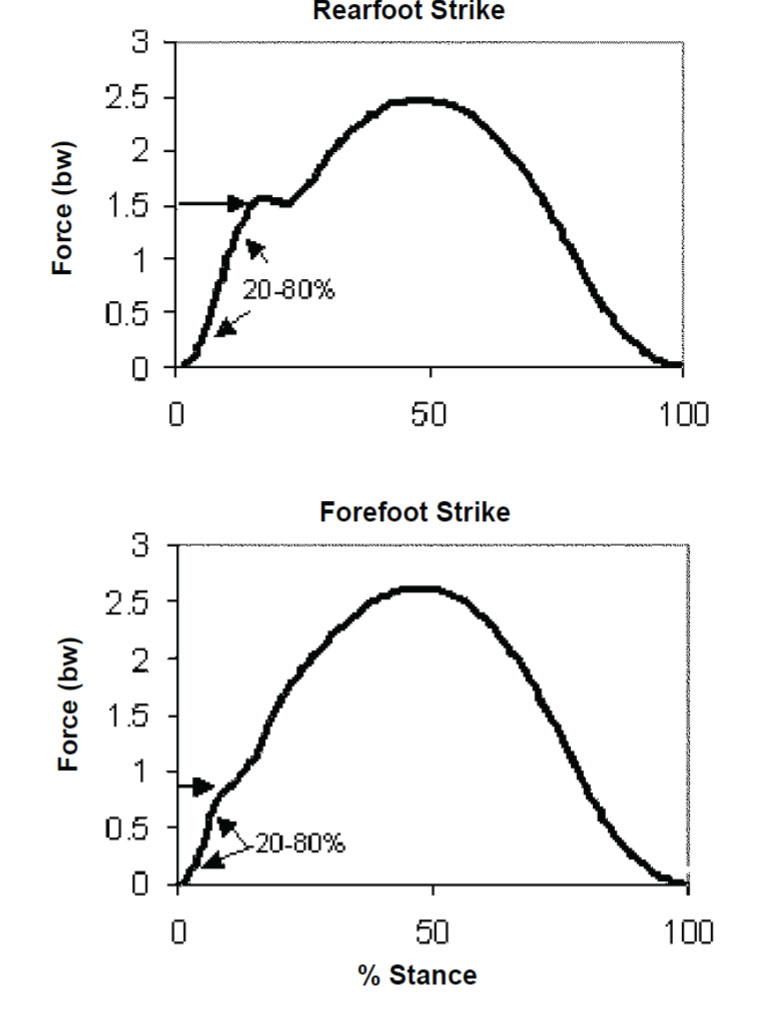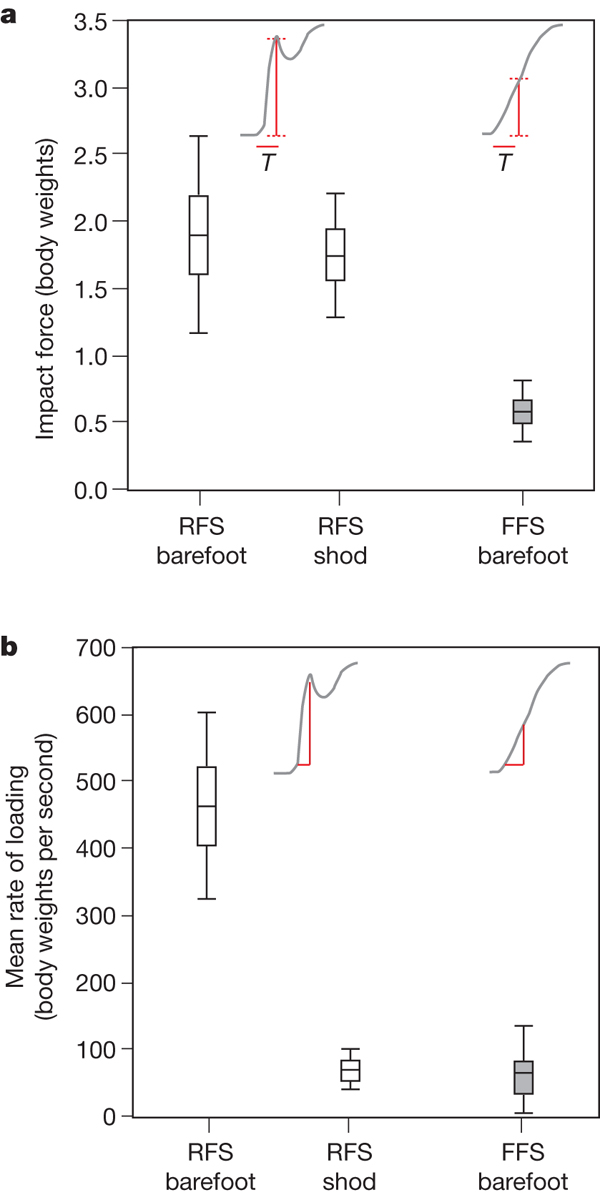Audience: Runners and Therapists
Background: Changing running form, particularly through the aid of minimalist or barefoot running, is often proposed to change the type of forces that the body experiences during running. This in turn may influence of risk for injuries.
Source of information: Zadpoor et al (2011), Lieberman et al (2010) and Squadrone et al (2010)
I love the idea that there exists a proper way to do something. In sport or any movement this can be considered ideal form (I consider form to be the dynamic equivalent of posture). I question whether there is an ideal way to do something but it still fascinates me. Barefoot running and minimalist running is garnering a lot of attention because of some research suggesting how it can change the stride characteristics of a runner. And how it changes the characteristics without the person really consciously trying to change their form is also interesting. It is proposed that barefoot running is natural…and the feedback that your feet receive from the ground will automatically cause you to modify your stride to a proposed more ideal technique. If we extend the excellent biomechanics research (which the authors of those papers caution against but others in the lay press still do) we might argue that the differences that exist in changing running mechanics lead to fewer injuries. See my previous post (click here) comparing the differences in running mechanics during barefoot running, shod running with a heel strike and shod running with a forefoot strike.
The question is…What is the link to injury reduction? Update, well after this post was written a paper did come out looking at running technique and injuries. I’m sure this is the first of many to come. See it here at Alex Hutchinson’s blog (http://sweatscience.com/lieberman-on-foot-strike-and-injuries-on-harvards-xc-team/)
Recap of changes in mechanics with barefoot running
First a quick recap of how barefoot running changes the loading when the foot strikes the ground. Lieberman’s work is excellent and a video is seen below. When the foot first strikes the ground (particularly in heel to toe running) there is an Impact transient or collision force. Notice the first big peak in the picture below. This force is then slightly decreased and then the ground reaction force starts to increase again as we push off of the ground. The second big peak is called the Active peak. The force pushing against the ground then decreases as the foot leaves the ground. See the picture below.
What Lieberman demonstrated was that the Collision force or that initial impact transient peak was significantly reduced when running barefoot and forefoot striking for habitually barefoot runners.
Lieberman wrote the following (emphasis is mine):
“At similar speeds, magnitudes of peak vertical force during the impact period (6.2 ± 3.7% (all uncertainties are s.d. unless otherwise indicated) of stance for RFS runners) are approximately three times lower in habitual barefoot runners who FFS than in habitually shod runners who RFS either barefoot or in shoes (Fig. 2a). Also, over the same percentage of stance the average rate of loading in FFS runners when barefoot is seven times lower than in habitually shod runners who RFS when barefoot, and is similar to the rate of loading of shod RFS runners (Fig. 2b). Further, in the majority of barefoot FFS runners, rates of loading were approximately half those of shod RFS runners”.
a, b, Magnitude (a) and rate of loading (b) of impact transient in units of body weight for habitually shod runners who RFS (group 1; open boxes) and habitually barefoot runners who FFS when barefoot (group 3; shaded boxes). The rate of loading is calculated from 200 N to 90% of the impact transient (when present) or to 6.2 ± 3.7% (s.d.) of stance phase (when impact transient absent). The impact force is 0.58 ± 0.21 bodyweights (s.d.) in barefoot runners who FFS, which is three times lower than in RFS runners either barefoot (1.89 ± 0.72 body weights (s.d.)) or in shoes (1.74 ± 0.45 body weights (s.d.)). The average rate of impact loading for barefoot runners who FFS is 64.6 ± 70.1 body weights per second (s.d.), which is similar to that for shod RFS runners (69.7 ± 28.7 body weights per second (s.d.)) and seven times lower than that for shod runners who RFS when barefoot (463.1 ± 141.0 body weights per second (s.d.)). The nature of the measurement (force versus time) is shown schematically by the grey and red lines. Boxes, mean ± s.d.; whiskers, mean ± 2 s.d.
Interesting? The RATE of loading is not different when heel striking in shoes when compared with forefoot barefoot striking.
I think this is a very interesting finding and I certainly don’t fully understand its implications. Where it may be relevant is the research that looks at impact forces and injury risk.
A recent review paper (click here) by Zagpoor (2011) found that peak impact loading was not related to the occurrence of stress fractures in the lower extremity but that the RATE of loading was related to the occurrence of stress fractures. So, the variable that is changed so greatly with barefoot running and forefoot striking does not appear related to injury risk in the studies that we have to date (it still might be, I’m not ready to rule it out) but the variable that shows no difference between the forefoot barefoot group and the rearfoot shod runners is related to injury. Cool…maybe?…I don’t know.
A final caveat.
What I don’t know from these studies is how an individual’s loading profile changes when going from rearfoot shod to a barefoot running gait that was trained over a long period (or forefoot running). I would wager that on an individual basis we might have an argument that we can change the rate of loading when going to barefoot or forefoot striking. In fact, I know that this can be done with simply giving feedback on loading and asking individuals to run softer. Dr. Irene Davis (click here) has shown that this type of feedback can change loading rates. Her work did not investigate kinematics so I don’t know how her patients changed their stride but I would surmise that many are taking a smaller stride and probably landing more midfoot.
Final caveat, I actually asked Dr. Davis about Lieberman’s finding. She believes that a couple people were outliers in the study and this dramatically increased the rate of loading for the group average. This certainly seems feasible considering the low numbers in the study population.
Adios,
Greg Lehman





